Categories: Featured Articles » Interesting electrical news
Number of views: 38480
Comments on the article: 4
Solar lights
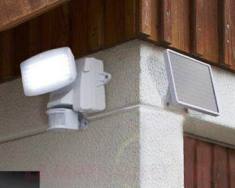 Hearing about solar luminaires (luminaires powered by solar panels), many dismissively give up. Chinese products sold in the store with the proud name “lamp” are suitable only for the role of a firefly. However, they illustrate the modern capabilities of the semiconductor industry. A decade and a half ago, luminaires powered by solar modules were used only in astronautics or in special equipment. Such components were not available to the general consumer.
Hearing about solar luminaires (luminaires powered by solar panels), many dismissively give up. Chinese products sold in the store with the proud name “lamp” are suitable only for the role of a firefly. However, they illustrate the modern capabilities of the semiconductor industry. A decade and a half ago, luminaires powered by solar modules were used only in astronautics or in special equipment. Such components were not available to the general consumer.
Intuitively, that self-powered luminaires can find application where it is impossible or disadvantageous to supply electrical energy. In such cases, use battery power. The battery life of a solar lamp is determined by the battery capacity and type of light source. But the battery requires regular recharging, so there is no need to talk about the complete autonomy of the lamp.
With the advent after 1998 bright white LEDs the problem of choosing a light source for stand-alone lamps has been greatly simplified. The efficiency of modern LEDs has exceeded the mark of 120 lumens / watts, which is an order of magnitude higher than incandescent lamps of low power. The development of solar cells did not stand still. The efficiency of solar energy conversion increased, the price decreased.
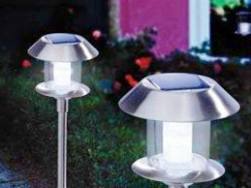 In general, the design of a modern stand-alone lamp includes sunlight conversion module, a battery, one or more LEDs and an electronic circuit that monitors the battery charge and the lamp on time. With the exception of the finished construction of the aforementioned toy fixtures, more serious designs are designed and installed taking into account specific operating conditions.
In general, the design of a modern stand-alone lamp includes sunlight conversion module, a battery, one or more LEDs and an electronic circuit that monitors the battery charge and the lamp on time. With the exception of the finished construction of the aforementioned toy fixtures, more serious designs are designed and installed taking into account specific operating conditions.
As an example, consider a lamp to illuminate a street name plate and house number. Typically, an incandescent lamp with a power of 25-40W is used for these purposes, which quickly burns out. Using a 3W LED lamp, you can get enough light.
Such a set will include a solar module with a power of 10 W at 12 V, a battery charge control circuit, a battery with a capacity of at least 7 A / hours and a 3 W, 12V LED lamp. Focusing on products manufactured in the CIS countries, such a pleasure will cost about 3,500 rubles, not counting the installation work. And this is only the lower price limit.
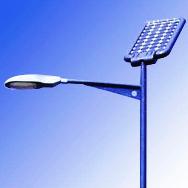 Even more impressive amounts need to be laid out for high power solar lamps, such as outdoor street lighting. In addition to the components listed above, an inverter will be required to convert to 220V alternating voltage, which is necessary to power efficient discharge lamps.
Even more impressive amounts need to be laid out for high power solar lamps, such as outdoor street lighting. In addition to the components listed above, an inverter will be required to convert to 220V alternating voltage, which is necessary to power efficient discharge lamps.
Autonomous lamp with sodium lamp DNaT-250W, which is powered by 2 modules of the FSM-300 W type, with the remaining necessary components will cost more than 110 thousand rubles.
But the problem is not only in the high price of such lamps. In the end, with advertising purposes, many companies are implementing projects of autonomous lighting systems, not looking at costs. A vulnerable element remains a key element of solar-powered lighting fixtures - batteries.
If in the summer their operation does not cause any problems, then in winter at subzero temperatures the batteries lose capacity, and against the background of a short winter day, when the battery recharging time is 1/3 days at best. In a discharged battery, the density of the electrolyte decreases and it freezes, after which the battery can be safely disposed of.
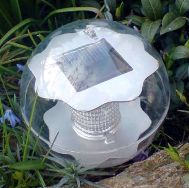 Of course, you can install modern types of maintenance-free batteries with an electrolyte in the form of a gel, but the price rises sharply, and the problem with low temperatures is not eliminated.
Of course, you can install modern types of maintenance-free batteries with an electrolyte in the form of a gel, but the price rises sharply, and the problem with low temperatures is not eliminated.
Recently increasing interest in non-volatile devices has stimulated the development of batteries using the latest technology. For instance, using graphene films.
The development of Russian scientists — photoelectrochemical supercapacitors for the simultaneous conversion and accumulation of solar energy — has excellent prospects. Being the closest relative of ionistors, photocondensers are manufactured using nanocarbon tubes.
Their capacity can reach 10,000 Farads. Photocondensers have an energy conversion efficiency of sunlight in the region of 10%, specific discharge energy of at least 12 W / h per kilogram of weight and more than 7000 charge-discharge cycles (15 years of continuous operation).
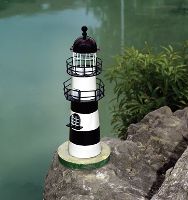 But all these are questions of the future. For those who already today have a burning desire to bring futuristic lighting elements to the landscape design in their suburban area, two series of solar lamps from different manufacturers can be recommended.
But all these are questions of the future. For those who already today have a burning desire to bring futuristic lighting elements to the landscape design in their suburban area, two series of solar lamps from different manufacturers can be recommended.
Solar lamps of the Wolta GARDEN series, Chinahas a price range from 150 to 1160 rubles. More expensive products of the Eglo Solar series, Austriahave a range of prices from 480 to 2250 rubles.
The difference between manufacturers and the cost of fixtures is associated only with the design of the external design and the materials used. Their technical characteristics are almost identical.
As a result, we can conclude that despite the growing interest in self-powered luminaires, their technical characteristics are so modest that there is no need to talk about mass application in the coming years.
Read also: Solar Power For Home
See also at bgv.electricianexp.com
:
